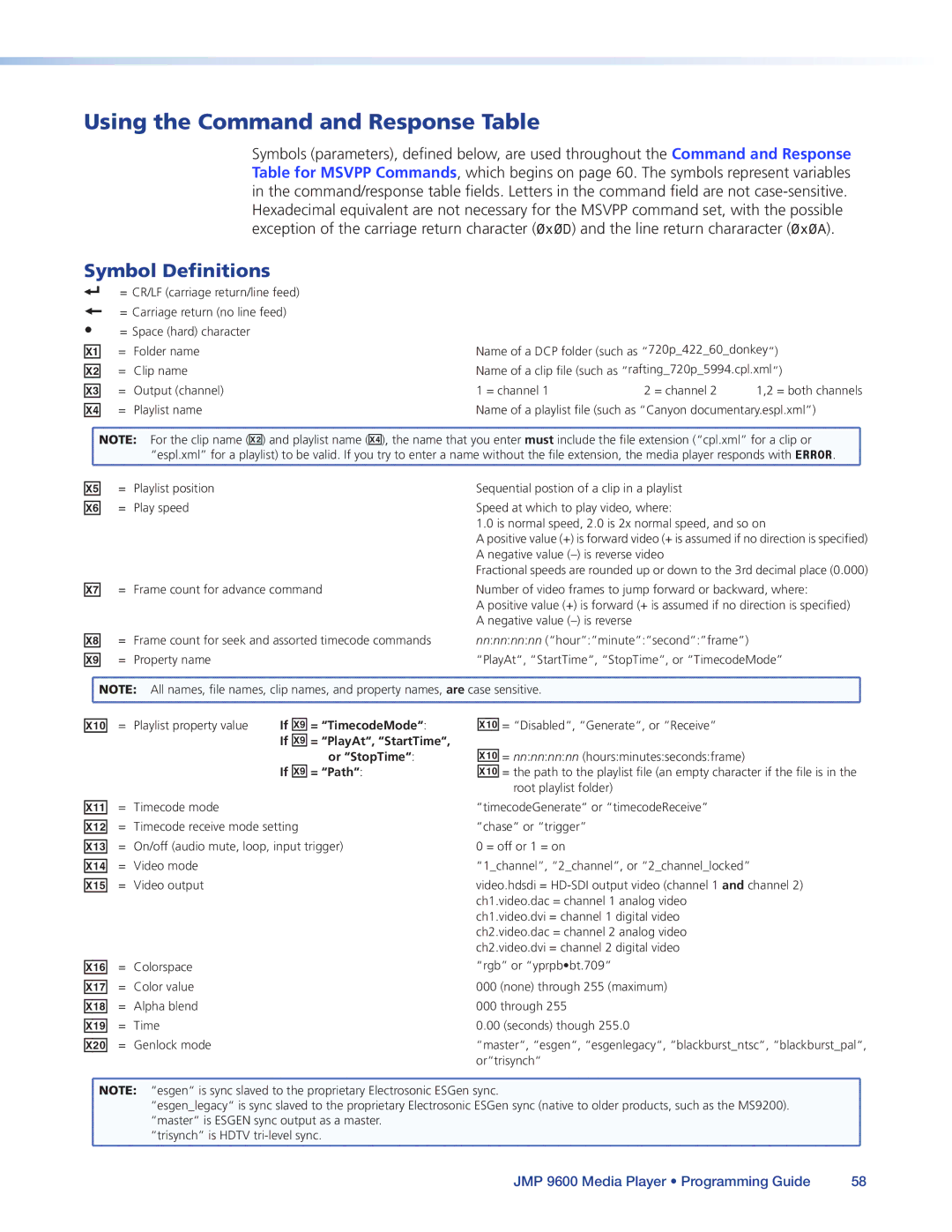
Using the Command and Response Table
Symbols (parameters), defined below, are used throughout the Command and Response Table for MSVPP Commands, which begins on page 60. The symbols represent variables in the command/response table fields. Letters in the command field are not
Symbol Definitions
] = CR/LF (carriage return/line feed)
}
•
X!
X@
X# X$
=Carriage return (no line feed)
=Space (hard) character
= | Folder name | Name of a DCP folder (such as “720p_422_60_donkey“) | ||
= | Clip name | Name of a clip file (such as “rafting_720p_5994.cpl.xml“) | ||
= | Output (channel) | 1 = channel 1 | 2 = channel 2 | 1,2 = both channels |
= | Playlist name | Name of a playlist file (such as “Canyon documentary.espl.xml”) | ||
![]() NOTE: For the clip name (X@) and playlist name (X$), the name that you enter must include the file extension (“cpl.xml” for a clip or
NOTE: For the clip name (X@) and playlist name (X$), the name that you enter must include the file extension (“cpl.xml” for a clip or ![]() “espl.xml” for a playlist) to be valid. If you try to enter a name without the file extension, the media player responds with ERROR.
“espl.xml” for a playlist) to be valid. If you try to enter a name without the file extension, the media player responds with ERROR.
X%
X^
= | Playlist position | Sequential postion of a clip in a playlist |
= | Play speed | Speed at which to play video, where: |
|
| 1.0 is normal speed, 2.0 is 2x normal speed, and so on |
|
| A positive value (+) is forward video (+ is assumed if no direction is specified) |
|
| A negative value |
|
| Fractional speeds are rounded up or down to the 3rd decimal place (0.000) |
X& = Frame count for advance command | Number of video frames to jump forward or backward, where: |
| A positive value (+) is forward (+ is assumed if no direction is specified) |
| A negative value |
X*
X(
= | Frame count for seek and assorted timecode commands | nn:nn:nn:nn (“hour”:”minute”:”second”:”frame”) |
= | Property name | “PlayAt“, “StartTime“, “StopTime“, or “TimecodeMode” |
![]() NOTE: All names, file names, clip names, and property names, are case sensitive.
NOTE: All names, file names, clip names, and property names, are case sensitive.
X1) = Playlist property value | If X( = “TimecodeMode“: | X1) | = “Disabled“, “Generate“, or “Receive” |
| If X( = “PlayAt“, “StartTime“, | X1) |
|
| or “StopTime“: | = nn:nn:nn:nn (hours:minutes:seconds:frame) | |
| If X( = “Path“: | X1) | = the path to the playlist file (an empty character if the file is in the |
root playlist folder)
X1!
X1@
X1# X1$ X1%
=Timecode mode
=Timecode receive mode setting
=On/off (audio mute, loop, input trigger)
=Video mode
=Video output
“timecodeGenerate“ or “timecodeReceive”
“chase“ or “trigger”
0 = off or 1 = on
“1_channel”, “2_channel”, or “2_channel_locked”
video.hdsdi =
ch1.video.dvi = channel 1 digital video ch2.video.dac = channel 2 analog video ch2.video.dvi = channel 2 digital video
X1^
X1&
X1*
X1(
X2)
= | Colorspace | “rgb” or “yprpb•bt.709” |
= | Color value | 000 (none) through 255 (maximum) |
= | Alpha blend | 000 through 255 |
= | Time | 0.00 (seconds) though 255.0 |
= | Genlock mode | “master“, “esgen“, “esgenlegacy“, “blackburst_ntsc“, “blackburst_pal“, |
|
| or“trisynch“ |
![]() NOTE: “esgen“ is sync slaved to the proprietary Electrosonic ESGen sync.
NOTE: “esgen“ is sync slaved to the proprietary Electrosonic ESGen sync.
“esgen_legacy“ is sync slaved to the proprietary Electrosonic ESGen sync (native to older products, such as the MS9200).
“master“ is ESGEN sync output as a master.
“trisynch” is HDTV
JMP 9600 Media Player • Programming Guide | 58 |
